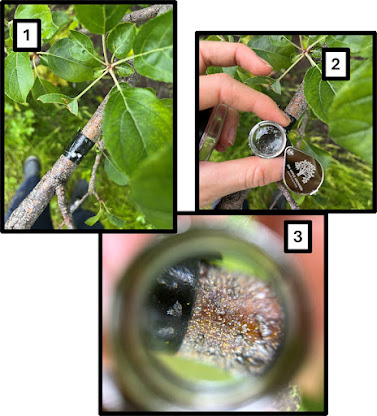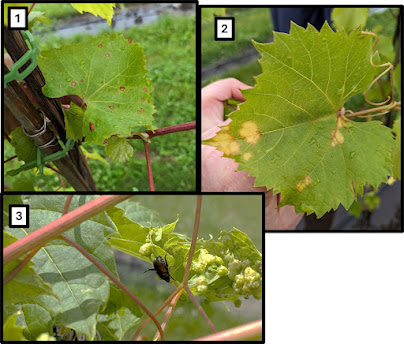Madeline Wimmer- UMN Fruit Production Extension Educator
This fruit update contains information about…
Apples- San Jose scale at the UMN Horticulture Research Center (HRC).
Grapes- Black rot and Japanese beetle sighting at the UMN HRC.
Minnesota Department of Agriculture IPM Fruit Update sign up form.
 Images: 1) An apple branch wrapped with reversed electrical tape within a population of San Jose scale (Diaspidiotus perniciosus), 2) using a jeweler’s lens to look closely, and 3) a magnified view of San Jose scale crawlers, which are the small yellow specks mixed among a cluster of scale coverings. Images taken by Kate Scapanski, UMN apple researcher at the UMN Horticulture Research Center (HRC.)
Images: 1) An apple branch wrapped with reversed electrical tape within a population of San Jose scale (Diaspidiotus perniciosus), 2) using a jeweler’s lens to look closely, and 3) a magnified view of San Jose scale crawlers, which are the small yellow specks mixed among a cluster of scale coverings. Images taken by Kate Scapanski, UMN apple researcher at the UMN Horticulture Research Center (HRC.)
Scale insects are unique in their appearance and life cycle. To the untrained eye, they can look like lichen or rough bark, but their strange shell-like structures are actually an exudate that houses a soft-bodied insect underneath. Similar to other insects, the scale life cycle begins with an egg from which a juvenile instar emerges known as a “crawler” that can eventually settle down and become a stationary adult.
The San Jose scale (Diaspidiotus perniciosus) affects multiple fruit trees, including apples. They are an indirect pest that causes harm by sucking up vascular juices from where they are stationed on a plant. One, or even a few scales, are not problematic, but when their populations are unmanaged and allowed to spread, that’s when harm becomes noticeable.
Within its lifecycle San Jose scales can go through two generations per growing season with overlap between generations. Males fly to mate with females around petal fall, and the first generation of crawlers are active during mid to late June.
Because of this active time window and because the UMN Horticulture Research Center (HRC) had previously identified San Jose scale in parts of their orchard, they began monitoring for crawlers last week using reversed electrical tape traps wrapped around branches with scales (see images above.) Through this trapping method, San Jose crawlers were observed during this time, and this will inform their pest management plan moving forward.
As alluded above, control options for San Jose scale begins by preventing major outbreaks. If, for example, there is one or two branches affected, these can be removed as a cultural management approach. To learn more about chemical management options for San Jose scale, refer to the Midwest Fruit Pest Management guide, which goes into specific detail about managing the crawler life stage starting on page 34.
 Images: 1) Foliar lesions typical of black rot (Guignardia bidwelli), 2) advancement of downy mildew (Plasmopara viticola) foliar symptoms, and 3) a Japanese beetle (Popillia japonica) near a grape leaf covered with grape phylloxera (Dactylosphaera vitifoliae) galls. Photos taken at the UMN Horticulture Research Center (HRC) by John Thull, UMN HRC Vineyard Manager.
Images: 1) Foliar lesions typical of black rot (Guignardia bidwelli), 2) advancement of downy mildew (Plasmopara viticola) foliar symptoms, and 3) a Japanese beetle (Popillia japonica) near a grape leaf covered with grape phylloxera (Dactylosphaera vitifoliae) galls. Photos taken at the UMN Horticulture Research Center (HRC) by John Thull, UMN HRC Vineyard Manager.
Black rot:
Within the UMN HRC’s “no spray” vineyard, downy mildew (Plasmopara viticola) had already begun showing symptoms on grape leaves during previous weeks, which was covered in our June 18th Fruit Update. This past week, black rot (Guignardia bidwelli) has also been progressing.
Japanese beetles:
The first Japanese beetle (Popillia japonica) was sighted at the UMN HRC on June 24th this year. Japanese beetles have been one of the most significant insect pests in grape production in recent years. Even though many grapevines can withstand a certain amount of defoliation from Japanese beetles, early management may still be preferable because Japanese beetles create a positive feedback system as increases in foliar damage, which leads to releases of volatile organic compounds, and Japanese beetle pheromones attract more beetles into the vineyard. As Japanese beetles continue to breed throughout the growing season, the females will drop to the ground to lay eggs. Adult beetles sighted the next year can come internally, but beetles will also enter from surrounding areas.
This fruit update contains information about…
Apples- San Jose scale at the UMN Horticulture Research Center (HRC).
Grapes- Black rot and Japanese beetle sighting at the UMN HRC.
Minnesota Department of Agriculture IPM Fruit Update sign up form.
Apples
San Jose scale at the UMN Horticulture Research Center (HRC)Scale insects are unique in their appearance and life cycle. To the untrained eye, they can look like lichen or rough bark, but their strange shell-like structures are actually an exudate that houses a soft-bodied insect underneath. Similar to other insects, the scale life cycle begins with an egg from which a juvenile instar emerges known as a “crawler” that can eventually settle down and become a stationary adult.
The San Jose scale (Diaspidiotus perniciosus) affects multiple fruit trees, including apples. They are an indirect pest that causes harm by sucking up vascular juices from where they are stationed on a plant. One, or even a few scales, are not problematic, but when their populations are unmanaged and allowed to spread, that’s when harm becomes noticeable.
Within its lifecycle San Jose scales can go through two generations per growing season with overlap between generations. Males fly to mate with females around petal fall, and the first generation of crawlers are active during mid to late June.
Because of this active time window and because the UMN Horticulture Research Center (HRC) had previously identified San Jose scale in parts of their orchard, they began monitoring for crawlers last week using reversed electrical tape traps wrapped around branches with scales (see images above.) Through this trapping method, San Jose crawlers were observed during this time, and this will inform their pest management plan moving forward.
As alluded above, control options for San Jose scale begins by preventing major outbreaks. If, for example, there is one or two branches affected, these can be removed as a cultural management approach. To learn more about chemical management options for San Jose scale, refer to the Midwest Fruit Pest Management guide, which goes into specific detail about managing the crawler life stage starting on page 34.
Grapes
Disease and insect pest sightings at the UMN Horticulture Research CenterBlack rot:
Within the UMN HRC’s “no spray” vineyard, downy mildew (Plasmopara viticola) had already begun showing symptoms on grape leaves during previous weeks, which was covered in our June 18th Fruit Update. This past week, black rot (Guignardia bidwelli) has also been progressing.
Black rot is a fungal disease that can affect grape foliage and shoots, and can cause major issues to fruits later in the growing season. Black rot infection events will occur faster when leaves are wet and temperatures are between 65-80 F. Foliar symptoms show up as bronze-colored lesions and infected berries will start off looking like a typical fruit rot. Over time, the berries desiccate and have a shriveled, dried appearance.
Because the fungal pathogen that causes black rot overwinters on infected clusters, removing mummified fruits from the vineyard can be an important management tactic for vineyards with a known outbreak. Maintaining a stricter fungicide program the following year will also be necessary as it can also overwinter on grapevine canes. For more information related to managing black rot in grapes, refer to the Midwest Fruit Pest Management guide grape section, starting on page 155.
Images: Early and late symptoms of black rot (Guignardia bidwelli) on grape fruit clusters. Credited photos retrieved from ipmimages.org.
The first Japanese beetle (Popillia japonica) was sighted at the UMN HRC on June 24th this year. Japanese beetles have been one of the most significant insect pests in grape production in recent years. Even though many grapevines can withstand a certain amount of defoliation from Japanese beetles, early management may still be preferable because Japanese beetles create a positive feedback system as increases in foliar damage, which leads to releases of volatile organic compounds, and Japanese beetle pheromones attract more beetles into the vineyard. As Japanese beetles continue to breed throughout the growing season, the females will drop to the ground to lay eggs. Adult beetles sighted the next year can come internally, but beetles will also enter from surrounding areas.
Japanese beetle traps can be used to monitor for the first beetle arrival, but should be removed after the first catch to prevent attracting more beetles into the area. Some research has been done to study the efficacy of specific trap-and-kill options for Japanese beetles, but current recommendations are to use traps for monitoring alone. For more information related to Japanese beetle management in grapes, refer to the Midwest Fruit Pest Management guide grape section, starting on page 167.
LINK FIXED: Minnesota Department of Agriculture IPM Fruit Update sign-up form.
For those who are not familiar, the MDA has been keeping reports on insect pest trapping incidences for apples and putting out an IPM newsletter for years. The newsletter complements information presented in the UMN fruit updates and has been valued by many Minnesota fruit growers.
If you are interested in subscribing to the MDA IPM Fruit Update series, follow the link below to sign up.
MDA IPM Fruit Update sign up form.
❖❖❖❖❖❖❖❖❖❖❖❖❖❖❖❖❖❖❖❖❖❖❖❖❖❖❖❖❖❖❖❖❖❖❖❖❖❖❖❖❖❖❖❖❖❖
The University of Minnesota Extension fruit production program would like to extend a thank-you to our fruit grower partners who make these reports possible.
Non-credited photos in these publications were taken by the author, Madeline Kay Wimmer, M.S.
❖❖❖❖❖❖❖❖❖❖❖❖❖❖❖❖❖❖❖❖❖❖❖❖❖❖❖❖❖❖❖❖❖❖❖❖❖❖❖❖❖❖❖❖❖❖
The University of Minnesota Extension fruit production program would like to extend a thank-you to our fruit grower partners who make these reports possible.
Non-credited photos in these publications were taken by the author, Madeline Kay Wimmer, M.S.

Comments
Post a Comment